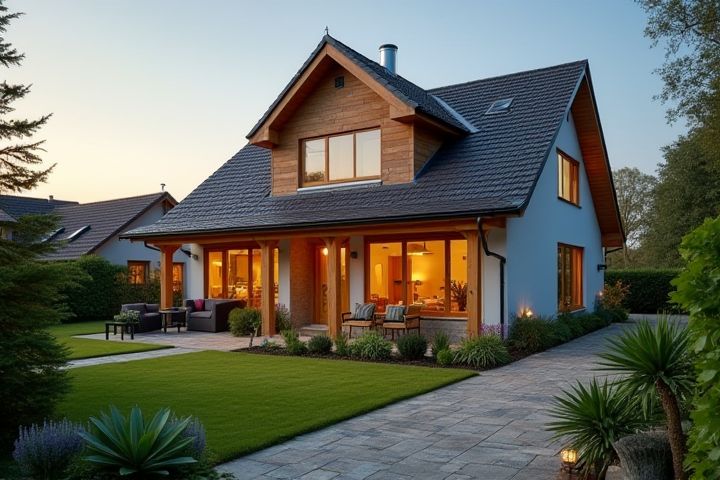
Investing in a big house can yield significant benefits, particularly in areas with rising property values. Larger homes typically provide more space, which is attractive to families seeking comfort and amenities. You may also benefit from increased rental income potential if you choose to lease extra rooms or an in-law suite. However, the costs associated with maintenance, property taxes, and insurance can be higher for larger properties. Ultimately, evaluating your financial stability and long-term goals is crucial before making such an investment.
Is A Big House Worth Investing In
Market Trends
Market trends indicate that large homes, typically exceeding 3,000 square feet, have seen price increases of up to 8% over the past year in suburban areas. Areas with strong school districts and low crime rates are particularly attractive, often resulting in homes selling within 30 days on average. As remote work continues to influence buyer preferences, the demand for spacious homes with dedicated office spaces is rising significantly. Investing in a big house may yield a strong return, especially in regions experiencing population growth and urban sprawl.
Resale Value
A big house typically offers significant potential for appreciation, especially in growing neighborhoods where property values are projected to rise. For instance, homes with over 3,000 square feet often see up to a 10% increase in resale value compared to smaller counterparts, particularly if they include desirable features like modern kitchens and ample outdoor space. Your investment can yield higher returns if the property is well-maintained and strategically marketed, appealing to families looking for spacious living. Moreover, nearby amenities such as schools, parks, and shopping can enhance your home's appeal, driving demand and ultimately boosting resale value.
Maintenance Costs
When investing in a big house, consider the maintenance costs, which can escalate dramatically. Based on averages, homeowners might spend 1% to 4% of the property's value annually on upkeep, translating to $5,000 to $20,000 for a $500,000 home. Larger spaces often incur higher expenses due to increased roofing, plumbing, and landscaping needs. Understanding these costs is crucial to ensure your investment remains financially viable over time.
Property Taxes
Investing in a big house often leads to significantly higher property taxes, which can range from 1% to 3% of the home's assessed value, depending on your location. For instance, a house valued at $500,000 could result in annual taxes between $5,000 and $15,000. These costs are crucial to consider, as they can substantially affect your overall budget and cash flow. You must factor in these additional expenses when calculating the return on investment for larger properties.
Utility Expenses
Investing in a large house can lead to significantly higher utility expenses, which typically include electricity, heating, cooling, and water costs. These expenses are often proportional to the size of the home, with average utility bills for larger properties exceeding $400 monthly, depending on location and energy efficiency. Insulating a big house properly can reduce heating and cooling costs by up to 20%, making it essential to consider energy-efficient appliances and sustainable materials. Evaluating these ongoing expenses is crucial when calculating the long-term return on your investment in a large property.
Location Impact
Investing in a sizable house primarily depends on its location, which significantly influences property value and long-term appreciation. Homes situated in high-demand areas, characterized by proximity to schools, shopping centers, and public transportation, typically show a resale value increase of 10-15% over time. In urban settings, a spacious house can provide you with a comfortable living environment while also serving as a lucrative rental property, yielding potential annual returns of 8-12%. Choosing a location with low crime rates and good community amenities not only enhances your quality of life but also ensures a sound investment for the future.
Lifestyle Needs
Investing in a big house can significantly enhance your lifestyle by providing ample space for family gatherings and personalized amenities. With dedicated areas for hobbies, home offices, and recreational activities, a larger property caters to diverse lifestyle needs. Consider how a spacious environment can foster comfort, privacy, and organization, promoting overall well-being. Ultimately, your choice should align with long-term goals, financial stability, and the potential for property appreciation in your desired location.
Investment Goals
A big house can be a significant investment opportunity, especially if it aligns with your long-term investment goals. Historically, residential properties appreciate in value, with average annual growth rates in the U.S. housing market around 3-5%. If your objective is rental income, a larger property can generate higher cash flow, with multi-family homes often yielding up to 1% of the property's value per month in rent. Evaluating local real estate trends and understanding market demand will be critical in determining whether investing in a big house meets your financial aspirations.
Financing Options
Investing in a big house often requires substantial financing, with mortgage options typically ranging from fixed-rate to adjustable-rate loans. Conventional loans may require a down payment of 20%, while FHA loans can allow for as little as 3.5% down for qualified buyers. Interest rates fluctuate, with current averages hovering around 3.5% to 4.5%, meaning that securing a favorable rate can significantly impact your monthly payments and overall affordability. You should also consider additional costs such as property taxes, insurance, and potential renovation expenses, which can all affect your long-term investment value.
Future Upsizing/Downsizing
Investing in a large house can prove beneficial for future upsizing or downsizing, as it often offers greater flexibility in accommodating changing family dynamics or lifestyle needs. A spacious home with four bedrooms and three bathrooms typically appeals to larger families or those needing extra rooms for home offices and guest accommodations. As your life evolves, the potential for resale value increases, especially in areas experiencing growth, with property values appreciating by an average of 5-7% annually. Furthermore, the option to downsize later can help you capitalize on equity, allowing you to transition into a more manageable space while freeing up funds for other investments or retirement.
